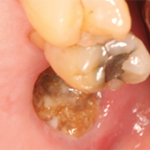One measure of bone strength is cortical thickness, and this increased with use of odanacatib as well, Dr. Edwards said.
The results over five years, shown in a Phase 2 trial of postmenopausal women, were even more impressive.2 At the lumbar spine, there was an increase of 11.9% in bone mineral density. In the case of total hip, it was about 6%.
“It’s very substantial; it’s not something that you’re going to miss,” she said.
Another plus was the patients’ response rate. “Most of the patients responded; there was not a large number of nonresponders,” Dr. Edwards said. “We tend to see about 4–5% of patients not responding to therapy. Here that was not an issue.”
The number of adverse events and discontinuations due to adverse events has been about the same as those on placebo.
The Promise
“So we have a drug that is an antiresorptive, that does not impair bone formation, but definitely shows effectiveness in inhibiting bone resorption,” Dr. Edwards said. “It increases bone mass. It increases volumetric bone mass. It increases biomechanical strength of the bone. It increases cortical thickness, all of which are elements that contribute to bone strength. So it seems fairly favorable.”
Before it can gain FDA approval, the investigators will have to show the drug prevents vertebral fractures, which has not yet been demonstrated, she said.
Romosozumab
Another promising osteoporosis agent, Dr. Edwards said, is the monoclonal antibody romosozumab that targets sclerostin, a protein in osteocytes whose main function is to inhibit bone formation.
A one-year study has shown increases in volumetric bone density at the spine and hip in patients on romosozumab. Like odanacatib, this drug has not yet been shown to prevent fractures, which will be a requirement before gaining FDA approval, Dr. Edwards said.
“It is very welcome to have a second anabolic agent,” Dr. Edwards said, “although this one will likely only be used for a year at a time [because] it loses some efficacy after 12 months. It opens up a new generation of drugs that we can consider for our patients.”
Thomas R. Collins is a freelance medical writer based in Florida.
References
- Eisman JA, Bone HG, Hosking DJ, et al. Odanacatib in the treatment of postmenopausal women with low bone mineral density: Three-year continued therapy and resolution of effect. J Bone Miner Res. 2011;26(2):242–251.
- Langdahl B, Binkley N, Bone H, et al. Odanacatib in the treatment of postmenopausal women with low bone mineral density: Five years of continued therapy in a phase 2 study. J Bone Miner Res. 2012;27(11):2251–2258.

